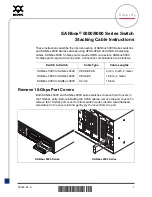
6. HELPFUL SUGGESTIONS
6.1 Prior to Installation
Before installing the Switch and connecting network devices, it is important to plan the
network's layout. Things you should consider include:
•
Dedicated Bandwidth:
File servers and other high-traffic hardware improve their
performance if they have their own dedicated 10Mbps, 100Mbps bandwidth.
•
Full-duplex:
Determine which devices support Full-duplex connections.
•
Fast Ethernet:
Make sure rules for cable lengths and categories are followed.
•
Auto-negotiation:
Devices with different speeds may be easily swapped when the other
end of the cable is fixed to a port with Auto-negotiation.
6.2 Fast Ethernet
100BASE-TX is called "Fast Ethernet". In Fast Ethernet, data travels ten times faster (100Mbps)
than in traditional Ethernet (10Mbps).
Note:
If your 10BASE-T network currently uses Category 5 TP cabling, you can instantly
upgrade the network to a 100BASE-TX network by changing network devices.
Note:
100BASE-TX use Category 5 TP cabling. The standard Category 5 TP cabling pin-out as
the following figures:
RJ-45 Jack Front View
EIA/TIA
568A
1 W/Green
2 Green
3 W/Orange
4 Biue
5 W/Blue
6 Orange
7 W/Brown
8 Brown
P2
P4
P1 P3
RJ-45 Jack Front View
EIA/TIA
568B
1 W/Orange
2 Orange
3 W/Green
4 Biue
5 W/Blue
6 Green
7 W/Brown
8 Brown
P2
P4
P1 P3
6.3 MAC Address Table
Every Ethernet data packet includes both source and destination addresses. This six (6) bytes
ID is called the MAC (Media Access Control) Address.
The Switch can automatically learn and store MAC addresses. However, the MAC address
table is volatile: it disappears when the Switch is powered “OFF” or reset.
Note:
When the network needs reconfiguration, we recommend you to turn off the power first.
After all nodes have been moved, turn the Switch back "ON" to rebuild the internal MAC
address table.
27


































